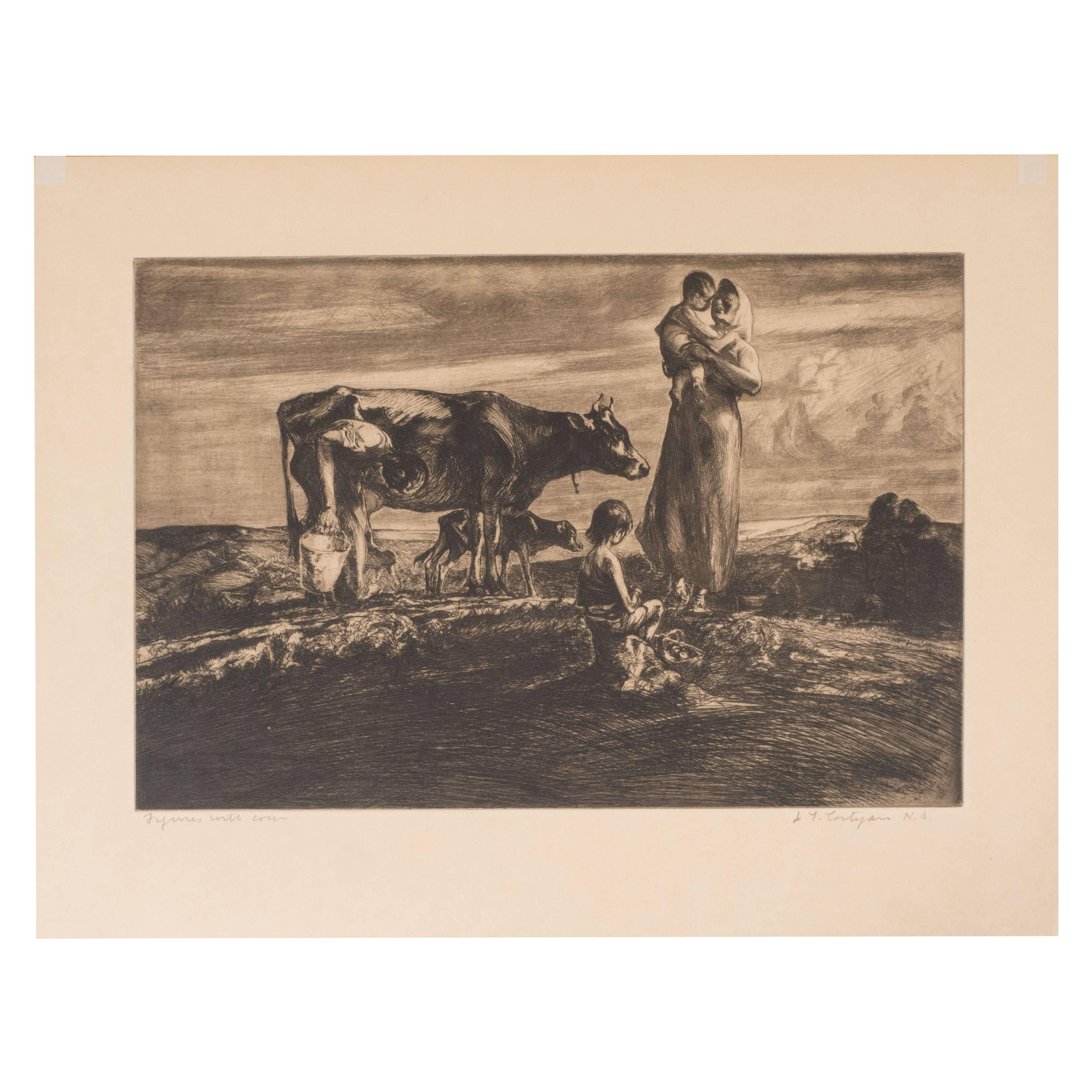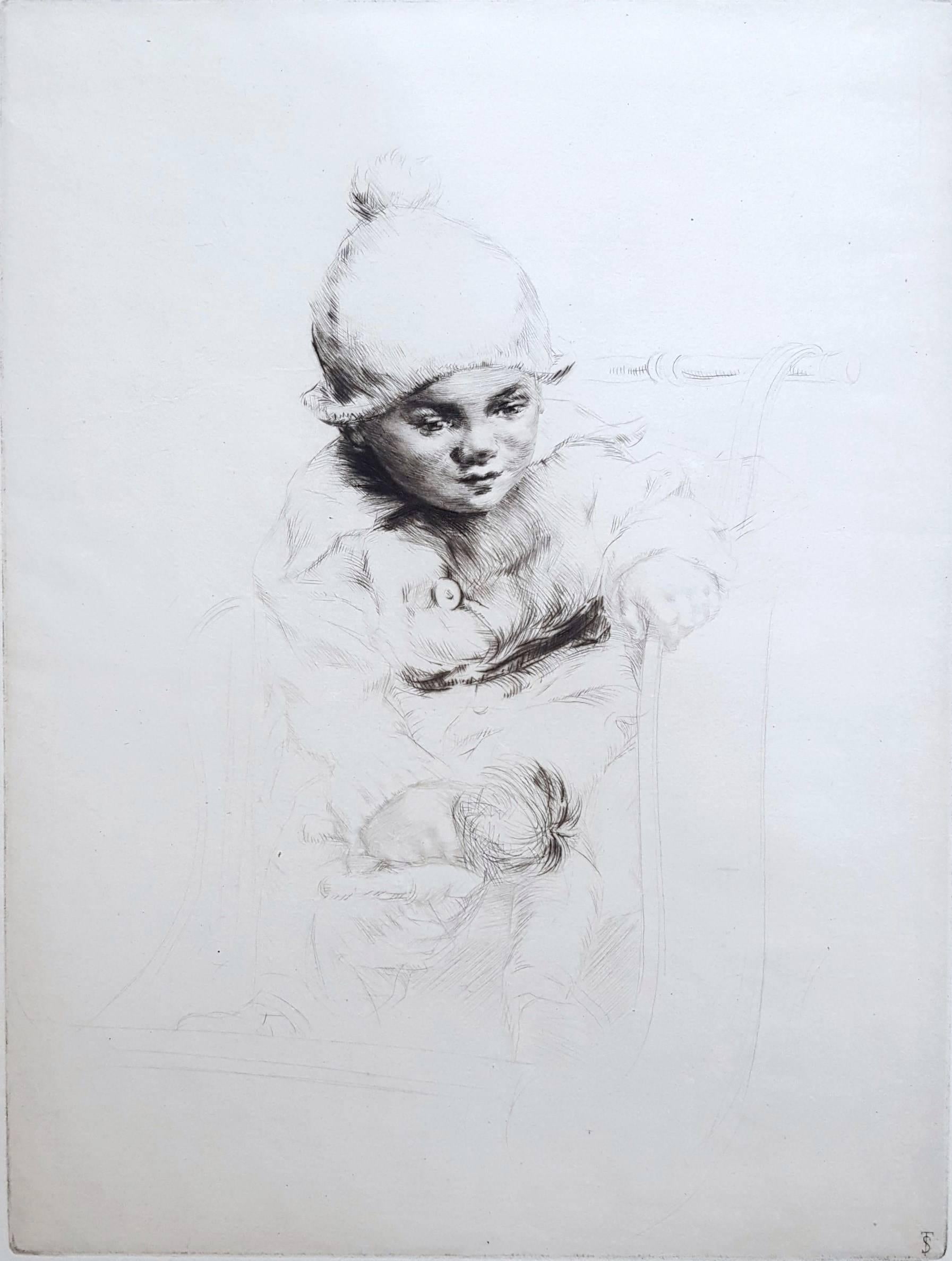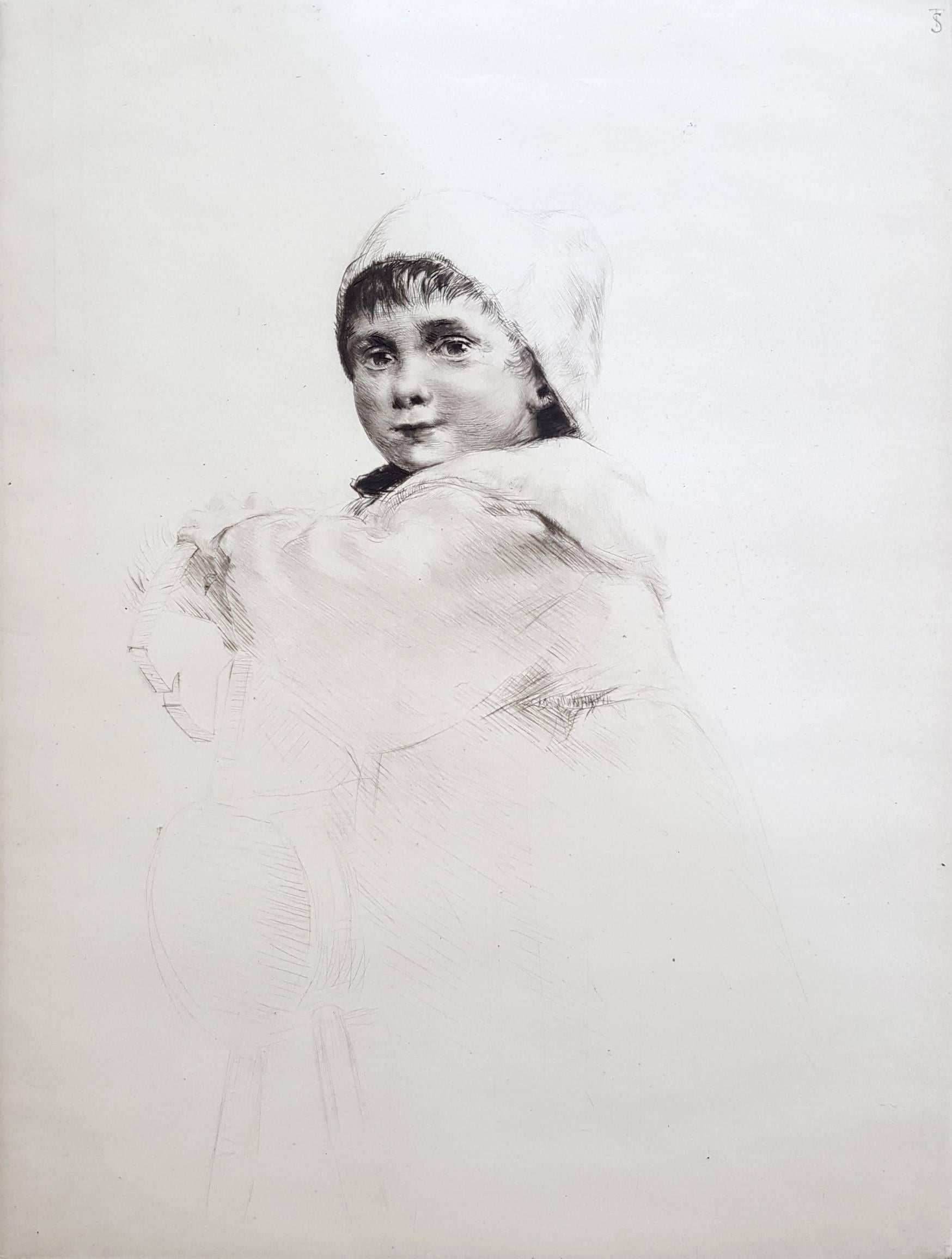Items Similar to Berthe
Want more images or videos?
Request additional images or videos from the seller
James Jacques Joseph TissotBerthe1883
1883
About the Item
Berthe
Etching with drypoint, 1883
Signed in the plate (see photo)
This etching was inspired by an 1882/3 pastel which the artist included in his ambitious "Femme a Paris" exhibition at Galerie Sedelmeyer, Paris, in 1885.
Reference: Beraldi 65
Wentworth 74, published state
Tissot 76
Condition: Excellent
Plate/Image size: 14 1/4 x 11 inches
Sheet size: 19 1/2 x 15 inches
Frame size: 23-1/2 x 20-1/4 inches
Donald Morris Gallery, Birmingham, Michigan (Morris had a distinguished collection of Tissot prints)
Chernoff Estate, Bloomfield Hills, Michigan
James Jacques Joseph Tissot
Jacques-Joseph Tissot was born in 1836, in Nantes in a seaport on the French coast. Throughout his life Tissot retained an affinity and fascination with all things nautical, and his marked ability to accurately paint rigging and shipboard scene paintings must have come from his boyhood. The son of a prosperous shopkeeper who was a devout Roman Catholic, the young Tissot was sent away to a boarding school run by Jesuits. Although initially unenthusiastic about the prospect of his son becoming an artist, Tissot senior eventually accepted the inevitability of his son's artistic pretensions.
In 1856 Tissot went to Paris to train as a painter. Here, at the Ecole des Beaux Arts the young Tissot met the young James McNiell Whistler (1834-1903), one of the most celebrated and unusual figures in 19th century art. At about this time Tissot also met, and became a friend of Degas (1834-1917) the Impressionist painter. Like Alma-Tadema, and Edward Burne-Jones, Tissot changed his name at this time to draw attention to himself. In his case he anglicized his Christian name to James. Tissot inherited the shrewd commercial instincts of his father, and like Alma-Tadema and Millais, was a painter-entrepreneur. In the 1860s he visited Italy, and in 1862 London. In 1864 Tissot exhibited his oil paintings at the Royal Academy for the first time, suggesting that he realized the potential of London as a source of wealthy patrons. He began to concentrate on contemporary scene paintings. In 1869 he produced caricatures for Vanity Fair magazine, including a brilliant caricature of the elegant, sophisticated Frederic Leighton at an evening reception.
Following the defeat of France and the occupation of Paris during the Franco-Prussian war, Tissot fled to England where he had a considerable number of contacts. He was initially the guest of the Editor of Vanity Fair, with whom he had become friendly, and who seems to have opened doors for him both socially and professionally. Tissot, hard working and shrewd, quickly became successful in London, where his oil paintings of social events and his conversation pieces rapidly became popular. These paintings look beautifully painted and were an interesting record of social life at the time, but were controversial. This was the time when commercially successful people were overtaking the landed aristocracy in wealth and as arts patrons. In some quarters Tissot’s paintings were regarded as depictions of the nouveau-riche. Ruskin was a particularly severe critic, describing them as "mere painted photographs of vulgar society." In 1873, Tissot bought the house in St John's Wood where he would live for the rest of his time in London, and started to become a significant figure socially. Tissot's success in London was regarded with envy by Degas and other painters of his circle in Paris.
In the mid 1870s Tissot met Kathleen Newton (1854-1882), an Irish divorcee with a distinctly colorful past. She had formed a sexual relationship with a man on a voyage to India to be married, and borne his child. Kathleen became Tissot’s model, muse, mistress, and the great love of his life. Many other successful men kept mistresses in St John's Wood, but they did not, like Tissot, live openly with them in adulterous relationships. This situation forced the painter to choose between his social life and Kathleen. To his credit he chose his lady. It would be wrong to think that Tissot became something of a hermit, as he and Kathleen Newton entertained their more bohemian artistic friends at home. But Tissot's days as a man-about-town were over, and he and Kathleen seem to have settled into a quiet life of domesticity. Kathleen's two children lived close by with her sister. Kathleen Newton was an extremely attractive young woman, and appeared in many of Tissot paintings at this time. In the late 1870s her health started to decline, with the onset of that great 19th century killer Tuberculosis. Tissot remained devoted to her. It is likely that the Roman Catholicism of both would not allow them to contemplate marriage. In 1882, the desperately ill Kathleen cheated consumption by committing suicide, and, as a result was not able to be buried in consecrated ground. With one week Tissot left his home at St Johns Wood, and never returned to it. The house was later bought by Alma-Tadema.
Tissot was devastated by his loss, and never really recovered from it. He seemed unable to accept the enormity and permanence of it. It is rumored that he considered marriage to other women later in life, but these affairs came to nothing. Like many English people at this time Tissot became interested in Spiritualism, and on a number of occasions tried to contact the dead Kathleen. The exotic French artist and his fallen women-one of the great 19th century English love stories. Initially Tissot carried on working back in Paris, in much the same manner as in London. Tissot produced a series of paintings of attractive, beautifully dressed women in sumptuous surroundings. These paintings were, for a time, extremely fashionable. Following this Tissot experienced a profound religious experience, and became increasingly devout. Tissot embarked on a series of religious paintings, visiting the Middle East on a number of occasions, to observe and paint backgrounds for his oil paintings. These paintings were well-received at the time, but in our more secular age have little appeal. James Tissot died on Friday 8th August 1902.
Courtesy: James Tissot
- Creator:James Jacques Joseph Tissot (1836-1902, French)
- Creation Year:1883
- Dimensions:Height: 14.25 in (36.2 cm)Width: 11 in (27.94 cm)
- Medium:
- Movement & Style:
- Period:
- Condition:
- Gallery Location:Fairlawn, OH
- Reference Number:
James Jacques Joseph Tissot
Jacques Joseph Tissot (French: [tiso]; 15 October 1836 – 8 August 1902), Anglicized as James Tissot (), was a French painter and illustrator. He was a successful painter of Paris society before moving to London in 1871. He became famous as a genre painter of fashionably dressed women shown in various scenes of everyday life. He also painted scenes and figures from the Bible.
About the Seller
5.0
Recognized Seller
These prestigious sellers are industry leaders and represent the highest echelon for item quality and design.
Platinum Seller
These expertly vetted sellers are 1stDibs' most experienced sellers and are rated highest by our customers.
Established in 1978
1stDibs seller since 2013
713 sales on 1stDibs
Typical response time: 1 hour
Associations
International Fine Print Dealers Association
- ShippingRetrieving quote...Ships From: Fairlawn, OH
- Return PolicyA return for this item may be initiated within 10 days of delivery.
More From This SellerView All
- L'Infante Marguerite (D'Après Velasquez)By Édouard ManetLocated in Fairlawn, OHL'Infante Marguerite (D'Après Velasquez) after a Manet painting in the collection of the Louvre, Paris (see photo) Etching, 1862-1864 Unsigned (as usual) A posthumous impression from...Category
1860s Impressionist Portrait Prints
MaterialsEtching
- J. Becquet, SculptorBy James Abbott McNeill WhistlerLocated in Fairlawn, OHJ. Becquet, Sculptor Etching & drypoint, 1859 Unsigned as issued From: The Thames Set Printed on this Japanese tissue Rich impression Condition: Excellent Plate/Image size: 9 7/8 x 7...Category
19th Century Impressionist Portrait Prints
MaterialsDrypoint, Etching
- MerieannaBy Almery Lobel-RicheLocated in Fairlawn, OHMerieanna Etching and aquatint, c. 1900 Signed by the artist in pencil lower right Titled in pencil lower right corner of sheet Annotated "4" lower left below image Publisher's dryst...Category
Early 1900s Impressionist Prints and Multiples
MaterialsAquatint
- Mademoiselle SablonBy Albert de BellerocheLocated in Fairlawn, OHMademoiselle Sablon Lithograph, 1907 Unsigned Provenance: estate of the artist Reference: Belleroche No. 383 Edition: c. 15 Condition: excellent Image size: 18 1/2 x 19 inches Sheet size: 24 1/4 x 18 1/2 inches Albert Gustavus de Belleroche, also known as Albert Belleroche, (22 October 1864 – 14 July 1944) was a Welsh-born painter and lithographer, who lived most of his childhood and his adulthood in Paris and England. He began as a painter, but at the turn of the century focused on lithography, for which he is most well-known. He was awarded the Chevalier de l’Ordre de Leopold by King Albert I of Belgium in 1933. Early life Albert de Belleroche, Lithograph of the artist's mother, Mrs. Harry Vane Milbank, circa 1900 Albert Gustavus De Belleroche was born on 22 October 1864 in Swansea. His parents were Brusseler Alice and Edward Charles, the Marquis de Belleroche, who died when he was three years old. His mother was the daughter of Desire Baruch. In March 1871, she married Harry Vane Millbank, the son of MP Frederick Milbank. He grew up in Paris and London and he used the surname Milbank until he was 30 years of age. He attained the title of count from his father's family of French Huguenot ancestry. Career and personal life La Danseuse (model Lili Grenier), circa 1890 In 1882, Belleroche studied briefly at Carolus-Duran's art school in Paris, preferring to study the masters like Johannes Vermeer and Sandro Botticelli at museums. He was a friend and studio-mate of John Singer Sargent in Paris and London, with the men making many sketches and paintings of each other. Some of the works that Sargent made of Belleroche are suggestive of an emotional relationship between the men and Belleroche may have been the love of Sargent's life. Dorothy Moss, an art historian, states "Sargent's portraits of Belleroche, in their sensuality and intensity of emotion, push the boundaries of what was considered appropriate interaction between men at this period." Belleroche was financially independent and did not need or desire to obtain work through commissions. Instead, he chose who he would paint, which included Japanese wrestler...Category
Early 1900s Impressionist Portrait Prints
MaterialsLithograph
- Portrait of a Man Facing LeftBy William Merritt ChaseLocated in Fairlawn, OHPortrait of a Man Facing Left Monotype printed in brown ink, c. 1880-1914 Signed in ink lower left: Chase (see photo) Provenance: Helen Chase Storm (the artist's daughter) Jackson Chase Storm (her son) Chapellier Galleries (as agent) James Bergquist, Boston References And Exhibitions: Exhibited at the Museum of Fine Arts, Boston and the Clark Art Institute, Williamstown, MA. (See MFA paperwork in photos) Reference: Ronald G. Pisano, Completed by D. Frederick Baker and Carolyn K. Lane, William Merritt Chase: Still Lifes, Interiors, Figures, Copies of Old Masters, and Drawings, Catalogue Raisonne, Vol. IV (New Haven and London: Yale University Press, 2010), Vol. 1, M. 8. (See photos of entry) William Merritt Chase (1840-2016) Born in Nineveh, Indiana Died New York, New York In 1883 Chase was involved in the organization of an exhibition to help raise funds for a pedestal for the Statute of Liberty. The exhibition featured loans of three works by Manet and urban scenes by the Italian Impressionist Giuseppe de Nittis. Both artists influenced Chase's Impressionistic style that gave rise to a series of New York park scenes. It is also thought that he was influenced by John Singer Sargent's In the Luxembourg Gardens (1879) which was exhibited in New York at this time. Indeed, Chase had met Sargent in Europe in 1881, the two men becoming lifelong friends with Sargent painting Chase's portrait in 1902. On another European trip in 1885, Chase met James McNeill Whistler in London. While Whistler had a reputation for being difficult, the two artists got along famously and agreed to paint one another's portrait. Eventually, however, Whistler's moods began to grate with Chase who wrote home stating "I really begin to feel that I never will get away from here". For his part, Whistler criticized Chase's finished portrait and, according to Hirshler, "complained about Chase for the rest of his life". While no record exists of Whistler's portrait of Chase; Chase's portrait of Whistler remains a well-known piece in his oeuvre. In 1887 Chase married Alice Gerson, the daughter of the manager of a lithography company. Though some fifteen years his junior (Chase was 37), he had known Alice for some time through her family's devotion to the arts. The pair, who would enjoy a happy marriage with Alice in full support of her husband's career, settled initially in Brooklyn...Category
1890s Impressionist Portrait Prints
MaterialsMonoprint
- Chinois inventa, dit-on, la poudre a canon, nous en fit donBy Georges RouaultLocated in Fairlawn, OHChinois inventa, dit-on, la poudre a canon, nous en fit don (The Chinese invented gunpowder, they say, and made is a gift of it) Aquatint, roulette, drypoint, acid bite, and scorper, 1926 From: Miserere, Plate 38 Initially started by Ambrose Vollard, this portfolio was published in 1948 by Editions de l'Etoile Filante, Paris This image is the cover illustration for the 1938 MOMA catalog...Category
1920s French School Portrait Prints
MaterialsDrypoint, Aquatint
You May Also Like
- Tête penchée et Bocal de PoissonsBy Henri MatisseLocated in London, GBEtching on Chine appliqué on Arches Velin paper, Edition of 25 Paper size: 28.5 x 38 cms (11 1/4 x 15 ins) Plate size: 14.9 x 19.6 cms (5 7/8 x 7 5/8 ins)Category
1920s Impressionist Portrait Prints
MaterialsEtching
- Masque aux rouleauxBy Henri MatisseLocated in London, GBAquatint on BFK Rives paper, Edition of 25 Paper size: 56 x 38 cms (22 x 15 ins) Image size: 34.8 x 27.7 cms (13 3/4 x 10 7/8 ins)Category
1940s Impressionist Portrait Prints
MaterialsAquatint
- Signed Original Pastoral Etching by John E. CostiganBy John CostiganLocated in New York, NYThis original, limited edition etching, was realized by the esteemed American artist John E. Costigan, who is represented in the collections of the Metropolitan Museum, the Philips M...Category
1930s American Impressionist Portrait Prints
MaterialsEtching
- "Mother and Child" A Signed Limited Edition Etching by John E. CostiganBy John CostiganLocated in New York, NYThis original, limited edition etching, was realized by the esteemed American artist John E. Costigan, circa 1930. He is represented in the collections of the Metropolitan Museum, th...Category
1930s American Impressionist Figurative Prints
MaterialsEtching
- Peggy /// Antique Victorian Etching Portrait Figurative British Children ChildBy Sidney TushinghamLocated in Saint Augustine, FLArtist: Sidney Tushingham (English, 1884-1968) Title: "Peggy" *Signed by Tushingham in pencil lower right. It is also monogram signed in the plate (printed signature) lower right Cir...Category
1910s Impressionist Portrait Prints
MaterialsEtching, Intaglio, Drypoint, Laid Paper
- Molly /// Antique Victorian Etching Portrait Figurative British Children ChildBy Sidney TushinghamLocated in Saint Augustine, FLArtist: Sidney Tushingham (English, 1884-1968) Title: "Molly" *Signed by Tushingham in pencil lower right. It is also monogram signed in the plate (printed signature) upper right Cir...Category
1910s Impressionist Portrait Prints
MaterialsEtching, Intaglio, Drypoint, Laid Paper
Recently Viewed
View AllMore Ways To Browse
Portrait 1903
1902 Portraits
The Wrong Man
Children Portraits In The Met
St Jacques
19th Childs Portrait
19th French Portrait Woman
19th Century Portrait Child
Portrait Of A Child 19th Century
St Joseph Antique
Antique Doors India
Italian School Muse
Religious And Christian
Tissot Used
Lady Dior Gray
Catholic Portrait
Antique Michigan
19th Century Portrait Young Man






